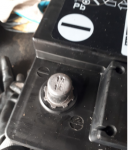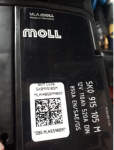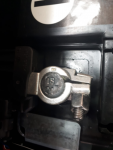Well, I've had my '14 since '18, and although it's never not started for me, I did notice it cranking slowly during our winters up here, have had a bunch of codes for low voltage events over the years, have had locks and aux heater codes, and other low voltage hints such as the EMS stepping in and turning things off to ensure it always starts, etc.
I've also been randomly checking it over the years, and have been always seeing it in the 11.6v - 11.3v range after being parked for as little as a few hours or overnight. I suspected the battery was the original, and I feel it had lasted long enough given its environment.
I was very tempted to purchase just a random battery in order to be cheap, but though about he inconvenience of having issues or getting stranded vs saving a few hundos and decided to go OEM.
Prices up here are just stupid on these things.... just for reference.
![]()
Dealership deal, but at least it's a VARTA
![]()
![]()
I was not expecting it to be this gigantic... typical "normal" battery on right for comparison.
Don't skip your Wheaties if you want to put one of these in... she's a pig.
![]()
Removing the driver's seat was a PITA, and there's no hinged seat, so all four bolts need to come out.
Getting the electrical connectors unclipped is even more of a PITA.
Lastly, the biggest PITA is operating the battery cover corner clips to get the cover off.
After a lot of struggling and swearing, I finally got a visual confirmation that the battery was original. An interesting side note... my carpet was already cut which lead me to believe that it had been previously replaced until I saw the details on the battery itself.
![]()
![]()
So I wrestled this mammoth out of there, and got the new one in. I hooked up the normal battery with jumper cables on the posts in the engine bay so I wouldn't have to deal with lost memory setting anywhere, etc.
Then I noticed that my new battery is already almost a year old.... oh well... I guess it had to travel over the pond and I'm sure the warranty starts on the purchase date, etc.
![]()
So after all that, the egg started and drove without any drama.
I did take two quick logs of the different starts pre & post change, and I did note that the controller was coded for a VARTA even though the battery was a MOLL brand. Got 8 years out of the "incorrect" coding, so I can't complain.
Here are the stats. I will look at the values again after I drive a little so it gives the system a change to put some more charge into this battery... I'm sure the dealer has had it on the shelf for a while.
I've also been randomly checking it over the years, and have been always seeing it in the 11.6v - 11.3v range after being parked for as little as a few hours or overnight. I suspected the battery was the original, and I feel it had lasted long enough given its environment.
I was very tempted to purchase just a random battery in order to be cheap, but though about he inconvenience of having issues or getting stranded vs saving a few hundos and decided to go OEM.
Prices up here are just stupid on these things.... just for reference.

Dealership deal, but at least it's a VARTA


I was not expecting it to be this gigantic... typical "normal" battery on right for comparison.
Don't skip your Wheaties if you want to put one of these in... she's a pig.

Removing the driver's seat was a PITA, and there's no hinged seat, so all four bolts need to come out.
Getting the electrical connectors unclipped is even more of a PITA.
Lastly, the biggest PITA is operating the battery cover corner clips to get the cover off.
After a lot of struggling and swearing, I finally got a visual confirmation that the battery was original. An interesting side note... my carpet was already cut which lead me to believe that it had been previously replaced until I saw the details on the battery itself.


So I wrestled this mammoth out of there, and got the new one in. I hooked up the normal battery with jumper cables on the posts in the engine bay so I wouldn't have to deal with lost memory setting anywhere, etc.
Then I noticed that my new battery is already almost a year old.... oh well... I guess it had to travel over the pond and I'm sure the warranty starts on the purchase date, etc.

So after all that, the egg started and drove without any drama.
I did take two quick logs of the different starts pre & post change, and I did note that the controller was coded for a VARTA even though the battery was a MOLL brand. Got 8 years out of the "incorrect" coding, so I can't complain.
Here are the stats. I will look at the values again after I drive a little so it gives the system a change to put some more charge into this battery... I'm sure the dealer has had it on the shelf for a while.
Original Batt said:
I didn't bother taking pics of the process at it was actually snowing while I was doing this crap and everything was getting wet as I was doing it outside.New Batt said:












